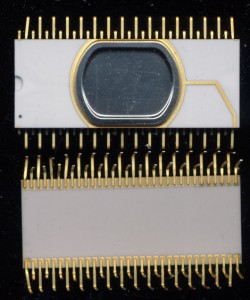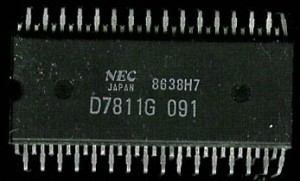CPU of the Day: NEC 78C11 Sample and the 78K family
Most microcontrollers store the program they run in ROM, most of the time this ROM takes the form of a Mask ROM. This means that its set at the factory when the die is being made, one layer (or more) of the die contains the ROM and the program is hardcoded into the device. Development versions almost always exist that allow programs to be developed before the mass produced Mask ROM chip, but still the mask must be tested.
This is such an example from NEC. It is a engineering sample of a uPD78C11 made in 1988. the 78C11 (and many others in the 78k family) used a 64 pin QUIP (Quad Inline Package), The 2 rows of staggered pins allowed for a 64 pin DIP in a much smaller foot print. The only problem was these chips are extremely delicate. They were designed to be soldered in and never removed. The standard package was plastic, but for the sake of testing, these are ceramic (its a bid easier to place/bond the dies on small batches on a ceramic package)
The NEC 78k family was and continues to be very popular. Its current version (the RL78) is made by Renesas, which was formed when Mitsubishi, Hitachi, and NEC joined their semiconductor businesses. 78K processors powered everything from word processors to washing machines and sewing machines. Now they are also commonly found in automotive applications.
Like many modern microcontroller families the NEC 78k traces its lineage back to the 1970’s. The family first appeared in 1980 as the uPD7801. The 7801 was a microcomputer based on the NEC 780 which was NEC’s version of the Zilog Z80. The 781x series released in 1982 expanded on the architecture by including an ADC, as well as a full 16-bit ALU (versus the 8-bit from the 780 and 780x) that even supported 16-bit multiply and divide. The 16-bit ALU made it a simple task for NEC to again extend the architecture to a 16-bit version. The instruction set was similar, though the naming was different then the Z80. In 1985 NEC moved the 78k line to a CMOS process, reducing power requirements and increasing the max clock from 12 to 15MHz.
The inclusion of many peripherals made the 78k a popular choice for many embedded applications. Its continued availability, and wide code base have allowed it to continue to thrive. And once again, a ‘modern’ MCU is based on a design from the 1970’s. Processor architectures rarely die, they just continue morphing.
Tags:
78k, Engineering Sample, NEC, Renesas, Z80
Posted in:
CPU of the Day



